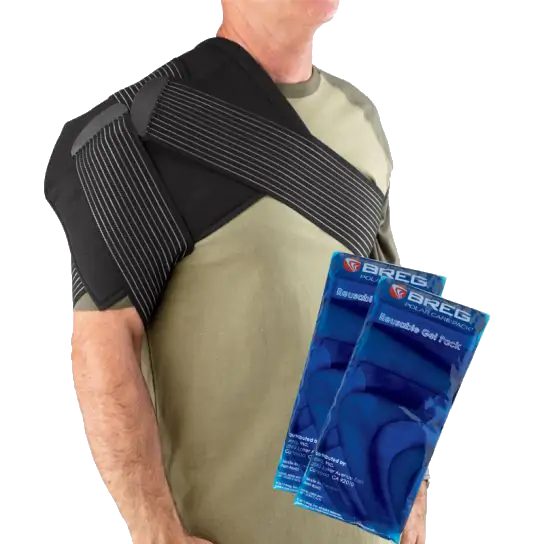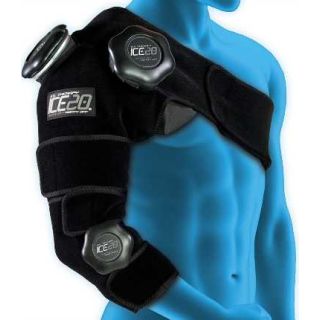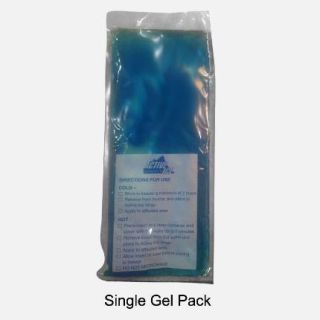Best Shoulder Ice Pack For Rotator Cuff
April 15, 2025Best Shoulder Ice Pack for Rotator Cuff: A Comprehensive Guide
Shoulder pain, particularly from rotator cuff injuries, can be debilitating, affecting daily activities and quality of life. Whether caused by a tear, tendinitis, or post-surgical recovery, managing pain and inflammation is critical. One of the most effective ways to alleviate discomfort is through cryotherapy, commonly delivered via ice packs. This article explores the best shoulder ice pack for rotator cuff issues, covering their benefits, features, and how to choose the right one for optimal relief and recovery.
Understanding Rotator Cuff Pain and the Role of Ice Therapy
The rotator cuff is a group of muscles and tendons stabilizing the shoulder joint, enabling a wide range of motion. Injuries like tears, strains, or tendinitis often result from overuse, trauma, or aging, leading to pain, swelling, and limited mobility. Post-surgical recovery, such as after rotator cuff repair, also involves significant inflammation. Applying cold therapy helps by narrowing blood vessels, reducing blood flow, and numbing nerves, which decreases swelling and pain.
Ice packs are a cornerstone of the RICE protocol (Rest, Ice, Compression, Elevation) for acute injuries and post-operative care. The best shoulder ice pack contours to the shoulder’s complex shape, stays cold long enough for effective therapy (typically 15–20 minutes), and is comfortable to wear. Let’s dive into why ice packs are essential for rotator cuff issues and what makes one stand out
Why Use an Ice Pack for Rotator Cuff Injuries?
Rotator cuff injuries, whether acute or chronic, benefit from cold therapy in several ways:
-
Reduces Inflammation: Cold constricts blood vessels, limiting fluid buildup in the joint, which is crucial for fresh injuries or flare-ups.
-
Numbs Pain: Ice dulls nerve activity, providing immediate relief from sharp or aching pain.
-
Aids Recovery: For those recovering from surgery, an ice pack for rotator cuff surgery helps manage post-operative swelling, speeding up healing.
-
Improves Comfort: A well-designed ice pack can make therapy sessions more tolerable, encouraging consistent use.
Choosing the best shoulder ice pack for rotator cuff injuries involves considering factors like coverage, flexibility, duration of cold, and ease of use, especially since the shoulder’s anatomy requires targeted application.
Key Features of the Best Shoulder Ice Pack for Rotator Cuff
Not all ice packs are created equal. The shoulder’s rounded shape and deep joint structure demand specific features for effective therapy. Here’s what to look for:
-
Contoured Design: The best ice pack for shoulder surgery should mold to the shoulder, covering the rotator cuff area (front, top, and side) without slipping.
-
Adjustable Straps: Secure straps ensure the ice pack stays in place, allowing mobility during use, which is vital for post-surgical patients.
-
Long-Lasting Cold: Gel-based packs that remain cold for 20–30 minutes are ideal, as shorter durations may not provide sufficient relief.
-
Compression: Combining cold with compression enhances effectiveness by pressing the cold deeper into tissues, reducing swelling more efficiently.
-
Versatility: Some packs offer hot and cold therapy, useful for chronic conditions where heat may help stiffness after inflammation subsides.
-
Durability and Reusability: A high-quality cold pack for shoulder surgery should withstand frequent freezing without leaking or losing flexibility.
These features ensure the ice pack meets the unique needs of rotator cuff pain, whether for acute injuries or surgical recovery.
Top Picks for the Best Shoulder Ice Pack for Rotator Cuff
Based on design, user feedback, and suitability for rotator cuff issues, here are some of the top ice packs available:
The Chattanooga ColPac is a favorite among physical therapists for its durability and flexibility. This reusable gel pack stays pliable even when frozen, conforming well to the shoulder. It provides up to 30 minutes of cold therapy, making it a strong contender for the best shoulder ice pack for rotator cuff surgery. Its large size covers the entire shoulder, ideal for post-operative swelling, though it may require a wrap for secure placement.
-
Pros: Long-lasting cold, professional-grade quality, reusable.
-
Cons: No built-in straps, so a separate wrap may be needed.
2. ActiveWrap Shoulder Ice Wrap
The ActiveWrap is designed specifically for shoulder injuries, with a dual-strap system that targets the rotator cuff area. It includes two gel packs for continuous therapy (one freezes while the other is used). The open-sleeve design is perfect for post-surgical patients with limited arm mobility, earning it a spot as one of the ice packs for shoulders after surgery.
-
Pros: Adjustable fit, excellent compression, long-duration cold (2+ hours with larger packs).
-
Cons: Slightly pricier than basic gel packs.
3. Activeice Shoulder Soft Wtap
The Activeice shoulder wrap provides cold therapy that last for an hour. It features a large gel pack that covers the shoulder and upper arm. Its adjustable Velcro straps make it easy to secure, even for smaller frames. Users praise its ability to stay cold for over 50 minutes, making it a great ice pack for shoulder surgery recovery.
-
Pros: Affordable, good coverage, dual-sided fabric (nylon for intense cold, plush for comfort).
-
Cons: Arm strap may be short for larger oversize biceps.
4. DeRoyal Shoulder Cold Therapy Wrap
For budget-conscious users, the DeRoyal Shoulder Cold Therapy wrap offers a flexible clay-based gel that molds to the shoulder. It’s smaller than others but effective for targeted relief, especially for tendinitis or minor tears. Its nylon strap keeps it in place, qualifying it as a solid best shoulder ice pack for daily use.
-
Pros: Lightweight, inexpensive, stays cold for 20 minutes.
-
Cons: Limited coverage for larger shoulders.
For advanced therapy, the Breg Polar Care Cube is a cold therapy machine with a shoulder-specific pad. It circulates ice-cold water for consistent cooling, ideal for extended sessions post-surgery. While pricier, it’s often recommended as the best ice pack for shoulder surgery for its precision and comfort.
-
Pros: Continuous cold, excellent for severe swelling, ergonomic pad.
-
Cons: Expensive, requires setup and power source.
Each of these options caters to different needs, from simple gel packs to advanced machines, ensuring there’s a solution for every rotator cuff issue.
How to Use an Ice Pack for Rotator Cuff Pain
Proper application maximizes the benefits of cold therapy while minimizing risks. Follow these steps:
-
Prepare the Ice Pack: Freeze the gel pack for at least 1–2 hours. For machines like the Breg, fill with ice and water as instructed.
-
Protect the Skin: Always wrap the ice pack in a thin cloth or use its built-in barrier to prevent frostbite. Direct contact can damage skin, especially after surgery.
-
Apply to the Shoulder: Place the ice pack over the rotator cuff area, ensuring it covers the front, top, and side of the shoulder. Secure with straps if available.
-
Time It Right: Use for 15–20 minutes every 2–3 hours for acute injuries or post-surgical swelling. Avoid longer sessions to prevent nerve or skin damage.
-
Monitor Skin: Check for redness or numbness. Remove the ice pack if discomfort occurs.
-
Rest and Elevate: Combine icing with rest and, if possible, elevate the arm to further reduce swelling.
For post-surgical care, follow your surgeon’s guidance, as some may recommend specific icing protocols using a best shoulder ice pack for rotator cuff surgery.
When to Use Ice vs. Heat for Rotator Cuff Issues
While this article focuses on ice, it’s worth noting when heat might be appropriate. Ice is best for:
-
Acute injuries (first 48–72 hours).
-
Post-surgical swelling (using an ice pack for rotator cuff surgery).
-
Inflammation from tendinitis or bursitis.
Heat, on the other hand, is better for chronic stiffness or muscle tension after inflammation subsides, typically 3–5 days post-injury. Avoid heat on fresh injuries or swollen areas, as it can worsen inflammation. If unsure, start with ice and consult a healthcare provider.
Risks and Precautions for Shoulder Ice Packs
While ice packs are generally safe, improper use can lead to complications:
-
Frostbite or Burns: Never apply ice directly to the skin. Use a cloth or the pack’s cover.
-
Nerve Damage: Prolonged icing (over 20 minutes) can harm nerves, especially in sensitive post-surgical areas.
-
Circulation Issues: Those with poor circulation, diabetes, or cold sensitivity should consult a doctor before using a cold pack for shoulder surgery.
-
Allergies or Skin Conditions: Ensure the pack’s materials don’t irritate your skin.
Always follow the manufacturer’s instructions and stop use if you notice adverse reactions.
Complementary Treatments for Rotator Cuff Recovery
Ice packs are most effective when paired with other strategies:
-
Rest: Avoid activities that strain the shoulder, especially lifting or overhead motions.
-
Compression: Wraps or braces can stabilize the joint, enhancing the effects of icing.
-
Physical Therapy: Gentle exercises, prescribed by a therapist, restore strength and mobility.
-
Medications: Over-the-counter anti-inflammatories like ibuprofen can complement ice therapy.
-
Medical Follow-Up: Persistent pain or swelling requires evaluation to rule out complications, especially after surgery.
Using the best shoulder ice pack for rotator cuff alongside these methods creates a holistic approach to healing.
Choosing the Right Ice Pack for You
Selecting the best shoulder ice pack for rotator cuff depends on your specific needs:
-
Budget: Basic gel packs like NatraCure are affordable, while machines like Breg are pricier but offer advanced therapy.
-
Severity: Post-surgical patients may benefit from continuous cooling systems, while minor injuries need only a simple wrap.
-
Mobility: If you need to move during therapy, choose a pack with secure straps, like ActiveWrap or Comfytemp.
-
Frequency of Use: Durable options like Chattanooga ColPac suit frequent icing.
Consider your lifestyle, pain level, and whether you’re recovering from surgery or managing chronic pain. Reading user reviews and consulting a physical therapist can also guide your choice.
Conclusion
Rotator cuff injuries, whether from tears, tendinitis, or surgery, demand effective pain management for recovery. The best shoulder ice pack for rotator cuff combines a contoured design, long-lasting cold, and secure fit to reduce inflammation and discomfort. Options like the Chattanooga ColPac, ActiveWrap, and Breg Polar Care Cube cater to various needs, from budget-friendly gels to advanced therapy machines. By using ice packs correctly—15–20 minutes with a barrier—and pairing them with rest, compression, and therapy, you can accelerate healing and regain shoulder function. Always consult a healthcare provider for persistent pain or post-surgical guidance to ensure the best outcomes.
Additional Resources:
Alternating Hot And Cold Therapy





